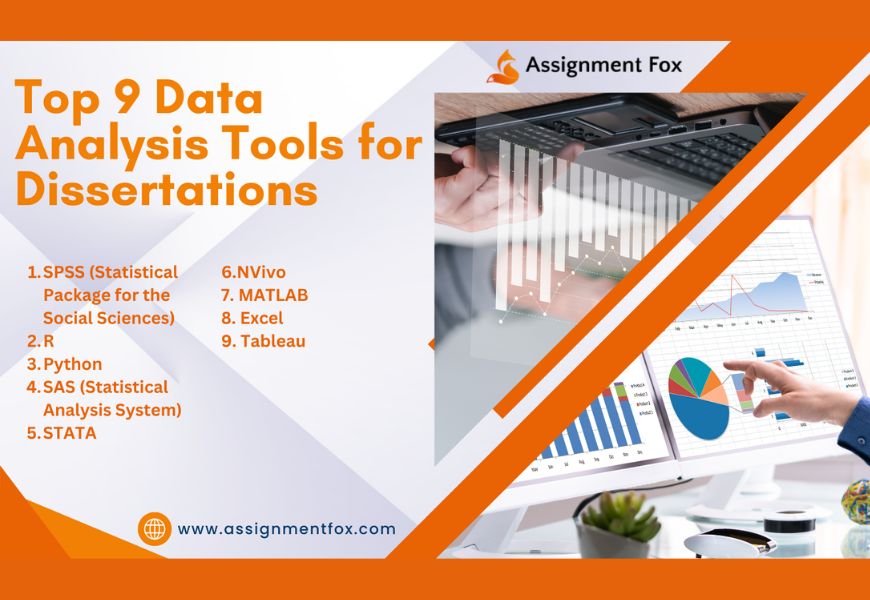Data analysis is a critical method when one is required to analyze complex data in academic research. Sometimes, getting robust and reliable methods to analyze complex data in educational research becomes more brutal and tiresome. This happens when a student, researcher, or academician is unaware of the right tool to analyze complex data. So, here we have explored the top 9 data analysis tools for dissertations that can make your data analysis work easier. Read on…
What Are Data Analysis Tools, And How Are They Useful?
Data analysis tools are software applications or programs the researcher uses to process and analyze the data. Using this tool, the researcher can get meaningful insights from raw information.
However, these data analysis tools for dissertations can be different, comparing their functionality, ranging from statistical analysis and data visualization to qualitative data coding and predictive modeling.
The data analysis tools are used in various ways, such as:-
- A massive data set is handled quickly and accurately for efficient data processing.
- Using these tools can create visual representations of data, which improves understanding.
- Data analysis processes ensure reproducibility where data can be easily replicated and verified.
- Tools also support informed decision-making by providing actionable insights.
Criteria for Choosing Data Analysis Tools
When a researcher chooses their data analysis tool, they must see this checklist and then select their data analysis tools.
- Always check how you are comfortable with the tool, which means ease of use of the interfaces and manageable learning curves are crucial.
- The tool must have better functionality with advanced features and analytical capabilities, which is essential.
- When you use it, the tool must be compatible with different data types and formats.
- Look for a tool that comes within your budget.
- Check if the tool has support and community features like documentation and tutorials, which can make a big difference.
Know the Top 9 Data Analysis Tools for Dissertations
This section will be attractive for you because here we will explore all the details about these ten tools for dissertation writing where you can get a brief idea.
SPSS (Statistical Package for the Social Sciences)
When measuring statistical analysis capabilities, the SPSS tool is best because of its long-established nature. The key feature of this tool is that it is excellent for descriptive statistics, regression analysis, ANOVA, and more.
Pros:
- Easy to use
- More used in social sciences
- Having strong analytical capabilities.
Cons:
- Costly
- Limited in handling large datasets compared to some modern tools
Usage:
It is an excellent tool for students who require comprehensive statistical analysis for social sciences, psychology, and other fields.
R
Students who require statistical computing and graphics can use R programming language data analysis tools for dissertations.
The R programming data analysis tools are extensively used in statistical and graphical techniques such as linear and nonlinear modeling, time-series analysis, and data visualization.
Pros :
- It is open-source software.
- Extensive package ecosystem
- Highly customizable
Cons:
The steeper learning curve needs to be sound in programming knowledge.
Usage:
Students can use data analysis tools for advanced statistical analysis and visualization across various research fields.
Python
Being a versatile programming language, Python is more used in data analysis because of its robust libraries.
Python data analysis tools have huge libraries such as Pandas, NumPy, SciPy, and Matplotlib, which help in data manipulation, statistical analysis, and visualisation
Pros:
- It is open-source software
- Versatile
- Cater-wide community support
Cons:
- Complicated to use.
- Very Expensive.
Usage:
More use in complex data analysis, machine learning projects, and any research work related to extensive data manipulation and visualization.
SAS (Statistical Analysis System)
SAS is an inclusive tool that is more applicable for advanced analytics, business intelligence, and data management. This tool best suits innovative statistical analysis, multivariate analysis, and data management competencies.
Pros:
- The tool is highly reliable
- Suitable for handling large datasets
- It has strong support and training
Cons:
- It is costly
- Not easy to use, having a complex interface
- Also, students face difficulties while learning these tools
Usage :
Students can use it in economics, health sciences, and industries where there is a need for robust data analysis.
STATA
Students can use these data analysis tools for dissertations when they require data analysis, data management, or graphics. It is a statistical software package students use for its features like data manipulation, statistical analysis, and graphical representation.
Pros:
- User-friendly tool anyone can use easily
- Best for panel data
- Strong community support
Cons:
- This tool does not have more features than R or Python.
- Cost-wise, it is costly.
Usage :
Students can use this tool seeking aid in economics, sociology, and political science for panel and time-series data analysis.
NVivo
It is a qualitative data analysis (QDA) software introduced for the researcher, who can use this tool to organize, analyze, and find insights in unstructured or qualitative data. It is well-known for its advanced coding features, such as text analysis, visualization, and organization of qualitative data.
Pros:
- Great tool for qualitative research.
- When used for data organization, this tool works wonders for students.
Cons:
- Very complex to learn
- Too expensive
Usage :
Students can use it for dissertations involving interviews, open-ended survey responses, and other qualitative data, which is a great tool.
MATLAB
Students doing technical computing, including numerical computation and data visualization, can use this high-performance language tool. It is more famous for its matrix computations, algorithm development, and data visualization features.
Pros:
- Excellent tool for engineering and scientific research.
- It has wide toolboxes such as Simulink, image processing toolbox, control system toolbox, and lots more.
Cons:
- High cost
- Using this tool for beginners is very complex.
Usage:
Students can use this tool for more statistical computing and numerical analysis.
Excel
Excel is a spreadsheet program widely used for data analysis and visualization capabilities. Excel has accessible features such as organizing the data correctly, doing statistical functions, and using it for pivot tables and charts.
Pros:
- Easily accessible.
- Easy to use.
- Excellent for straightforward analyses.
Cons:
- When students handle large datasets in Excel, the function is limited.
- Fewer advanced analytical features.
Usage :
They can be superb tools for dissertation writing only for smaller datasets and preliminary data analysis in various research fields.
Tableau
Tableau is an outstanding tool for data visualization that can convert data into interactive and shareable dashboards. It is more Popular for its unique features like interactive dashboards, data blending, and real-time analysis.
Pros:
- Easily accessible.
- Work great for data visualization and real-time analytics
Cons:
- As it has interactive dashboards and data blending, it is very costly.
- However, this tool can’t be used for primary analysis.
Usage :
Data analysis tools for dissertations like Tableau can be used to present research findings and visualize complex datasets.
Final Thoughts
These are the checklists of the top 9 Data analysis tools for dissertations in 2024. Anyone can choose a data analysis tool from the checklist above for their dissertation. In this blog, the reader can also learn about each tool’s pros and cons and usage and how to choose the right tool.
FAQ
- Which tool is mainly used for data analysis?
Data analysts use R, SAS, and SPSS statistical software for advanced statistical analysis.
- How long does it take to analyze data for a dissertation?
The data analysis may vary from one discipline to the other. For some, it takes a year; for others, it can be completed in a few months.
- What is your most vital data analytical tool?
These are a few of the most robust data analytical tools, such as R, Python, SQL, tableau, and Power BI.







